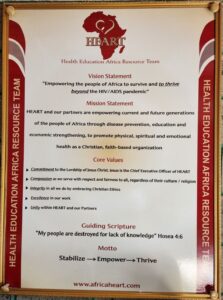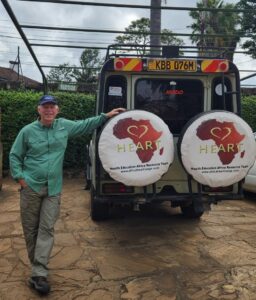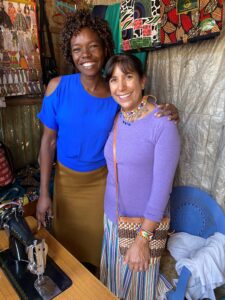A leadership journey worth taking — a journey that took me halfway around the world. In some ways, the journey started about five years ago when a client asked me to coach the Founder of a nonprofit organization based in Kenya that served women with HIV and their families. The Founder’s name is Vickie Winkler, and the nonprofit is HEART (Health Education Africa Resource Team, www.africaheart.com). Vickie started this organization 24 years ago. Over the months, as I worked with Vickie, she asked me if I would consider going to Kenya to work with her leadership team. At the time, I was very busy, and I declined the request.
About one and a half years ago, I started changing some of my consulting focus to allow more time to work remotely and possibly take on another project outside of the USA. As I did so, HEART regularly came to mind. In April of 2023, I called Vickie and asked if she was still interested in me coming alongside her Kenyan team. She said, “Absolutely.”
 I wanted to learn more about the culture, so I talked with two of the three Kenyan executives and started a coaching relationship with the Country Director, Nicholas Kamatu. Nicholas is a thoughtful, responsible manager who will soon complete his second master’s degree. He is an accountant/auditor and later got management and strategic planning training. He welcomed the coaching engagement.
I wanted to learn more about the culture, so I talked with two of the three Kenyan executives and started a coaching relationship with the Country Director, Nicholas Kamatu. Nicholas is a thoughtful, responsible manager who will soon complete his second master’s degree. He is an accountant/auditor and later got management and strategic planning training. He welcomed the coaching engagement.
As with any project of this nature, I wanted to start with an organizational health survey to get a perspective from the staff, including the leadership, on how they viewed the organization in terms of key factors, such as clarity of the organization’s vision, the level of trust, how they characterized the organization’s culture, and the relationship between staff and their immediate supervisor or manager.
More than 90 percent of the staff participated in the organizational health survey—a very high response rate. The written comments were articulate and insightful. Between the rated items and written responses, it was clear that staff understood the vision and mission of the organization—more so than most teams. While overall the scores were high, there were areas needing improvement, such as communication, staff recognition and engagement, and interdepartmental collaboration.
I recommended an agenda comprised of a series of eight workshops over two weeks starting with a review and discussion of the organizational health survey results. The agenda was approved, and the dates were set for us to travel to Kenya. The trip itself was daunting with nearly 30 hours of travel.
 During my consulting career, I have worked with more than 100 organizations, including several outside of the USA. This team was among the most welcoming from the driver, Charles Wafula, to Anna Kivuva and Charles Kahari in the Kitchen, as well as the members of the Executive Team.
During my consulting career, I have worked with more than 100 organizations, including several outside of the USA. This team was among the most welcoming from the driver, Charles Wafula, to Anna Kivuva and Charles Kahari in the Kitchen, as well as the members of the Executive Team.
All staff were invited to the opening session to discuss the organizational health survey responses. During this session, the team identified the following three areas as the highest priority:
- Improving Communication.
- Teamwork/unity/trust is an element that involves interdepartmental relationships.
- Senior leadership transition.
As the training sessions took place, other areas of focus emerged. Among them were actions involving strengthening the culture, staff safety, and steps to help the team mature into the “Performing Stage.”
During the second week, time was set aside for staff to work on a plan to move from insights gained to actions to be taken. Each action included staff assigned to work on it and due dates for deliverables. While the Insights to Action Plan was not fully completed by the end of the second week, they were well on their way.
This newsletter would not be complete without talking about the significance of the work HEART does. They currently provide HIV and other medications to more than 600 women. In this culture, there is a stigma attached to having HIV, not unlike our own. What is different, however, is that these women and their children are lowly regarded in their communities. Without donor support, the children cannot go to school. Many live in slums, like Kibera which is home to approximately 1.2 million people. Most of these families have no running water or toilets.
HEART, through grants and private party donations, provides school fees for more than 3,000 students. They also provide business and vocational training for these women, encouraging them to start businesses so that they can support their children. More than 300,000 adolescent girls have been provided with a year’s supply of sanitary towels, 4 undergarments, and educational training through their Freedom for Girls (FFG) project aimed at keeping these girls in school.
 We met with at least a dozen women who talked about their journeys of losing hope and waiting to die before someone introduced them to HEART. They talked about hope and a return of self-worth. They smiled as they shared their stories. We fought back tears as their stories deeply impacted us. We visited two who have started produce stands where they sell vegetables, and another, Carolina, who has started a seamstress shop in a small 4’x6’ space.
We met with at least a dozen women who talked about their journeys of losing hope and waiting to die before someone introduced them to HEART. They talked about hope and a return of self-worth. They smiled as they shared their stories. We fought back tears as their stories deeply impacted us. We visited two who have started produce stands where they sell vegetables, and another, Carolina, who has started a seamstress shop in a small 4’x6’ space.
Among the HEART’s staff, at least four are children of women who were in the program. One, Dr. Marianna Javeza, was a bright student who went all the way through medical school and is now the primary physician overseeing the medical outreach of HEART. This work is personal for her—a calling. She is trying so hard to address all the medical needs. She missed most of the workshops because a PINCC medical team was visiting, and they had a full calendar of cervical cancer screening and treatments. She only recently was assigned an RN intern who, like her, came from a family impacted by HIV.
My wife and I were taken by the sincerity of everyone and their desire to help these families. The needs are great. The resources are tight—but they are trusting that God will provide. While they have clinics and/or programs in several areas outside of Nairobi, they have a vision to bring hope, healing, and education further across the country and beyond.
It was a privilege to play a very small part in encouraging the leadership and their staff. To help them strengthen the fabric of their organization so that they can be even more effective in bringing a bigger HEART to Kenya.
For the Faith-Based
1 Peter 4:10-11 encourages us, “As each has received a gift, use it to serve one another, as good stewards of God’s varied grace: whoever speaks, as one who speaks oracles of God; whoever serves, as one who serves by the strength that God supplies—in order that in everything God may be glorified through Jesus Christ.” (ESV) This verse, and others, remind us that we all have gifts, and we are stewards of these gifts.
In reflecting on definitions of stewardship, I concluded that the word suggests a caring, yet responsible, approach to the accountability of people and things that have been entrusted to us, and gifts and/or talents are among those things entrusted to us.
While my gifts and talents lie in the areas of leadership, administration, and teaching, you have your own gifts and talents. Maybe your gifts and talents lie in service to others, teaching, encouragement, accounting, or something else.
Mother Teresa once said, “I am like a little pencil in his hand. That is all. He does the thinking. He does the writing. The pencil has nothing to do with it. The pencil only has to be allowed to be used.”[1] Are you willing to let God use your gifts? If so, God has a place that needs you—maybe in your church, community, or somewhere else in the world.
Reference:
[1] Edward W. Desmond, “Interview with Mother Teresa: A Pencil In the Hand of God,” Time Magazine, 4 December 1989, https://content.time.com/time/subscriber/article/0,33009,959149,00.html, accessed 8 March 2024.